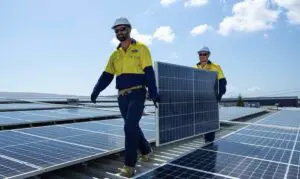The supervision of Australia’s electricity markets has reached a new level of absurdity after the principal market rule-maker sought to portray an apparently utopian image where Australia’s electricity customers think they are getting value for money and face only one blight on the horizon – the renewable energy target.
According to the Retail Energy Competition Review, issued on Tuesday by the Australian Energy Market Commission, the level of customer satisfaction is put by Newgate Research at 74 per cent (up from 66 per cent) – and 61 per cent of customers think they are getting value for money.
The findings are extraordinary, given that most electricity customers are now being asked to pay as much for their electricity as they would if they were only attached to a diesel gen-set, and in light of the high level of disconnection, and independent surveys showing trust in utilities at a low ebb.
The idea that households think they are getting good value for money for their power even appears to be contradicted by the report’s own findings – that the level of solar ownership is likely to nearly double in the next two years, from 20 per cent to 38 per cent, and that 21 per cent of solar households are looking to add battery storage over the same time.
But the report doesn’t stop there: It largely blames the renewable energy target for the recent surge in wholesale electricity prices, saying that the departure of large generators has caused less competition in hedging contracts and caused prices to rise.
Somehow, though, the 350 page report and its 70 page addendum fails to even mention the level of market gaming by big generators cited by smaller retailers, network operators, customers and governments. It seems everyone in the industry has noticed, except the very organisation that is commissioned to do so.
The AEMC plays a critical role in Australia’s energy industry because it sets the rules of the market. But it has been widely criticised for the slowness of its response to new technologies, and its dogged defense – justified in economic rationalist terms – of the status quo.
The AEMC has been given a kick-up the backside in recent months by COAG energy ministers frustrated by its dawdling on key market reforms. The Australian Energy Market Operator has pleaded to be given control of some much-needed rule amendments to ensure the market can keep pace.
The report – channeling, as it usually does, the interests of the incumbents – was greeted with eye-rolling by some consumer advocates, who pointed out the contrast between this report and the ACCC assessment published on the same day, which describes a not-so utopian assessment of the electricity market.
“The AEMC’s latest review of the retail market shows some much-needed in-depth consideration of the issues compared with their earlier reviews, and highlights key issues with the underlying components of the energy bill,” says Craig Memery, an energy expert at the Public Interest Advocacy Centre.
“But it still reads like someone is scraping of the bottom of the red paint tin to produce a rosier image of the retail market than the rest of us are seeing.”
The problem, say critics, is that this report effectively asks the major utilities to mark their own homework, because so much about retail margins and contracts on wholesale markets is invisible. Little wonder. then, that they decided that everything should be painted in such glowing terms.
One critic, Adrian Merrick, the founder of Energy Locals and a former senior executive with EnergyAustralia, said in response to the finding of customer satisfaction:
“This is possibly the best example I’ve seen of Stockholm Syndrome in action.” Although it could also have applied as much to a regulator captured by vested interests.
“Too many now just resign themselves to the annual price increase beatings because their captor has run some nice (and expensive) TV ads.
“It’s time for customers to rise up and take control of this. Energy users themselves could be responsible for the greatest shift this industry has ever seen, and market manipulation and reports such as this simply accelerate the payback of the alternatives. ”
Merrick was particularly astonished by the findings that retailers would offer discounts of 38 per cent, or around $500 a year, when asked by consumers. In his experience, the discounts offered are sometimes even higher, as the incumbent retailers wield their market power.
“The fact that an essential service in Australia can carry a discount between bugger all and approaching half price – given the ‘secret cupboard’ offers that retailers offer customers when they look like leaving – would be laughable if it wasn’t hurting customers so much,” Merrick says.
Quite how the AEMC managed to make no mention of the manipulation of wholesale prices in a 420 page report is a mystery.
That manipulation has been highlighted by major energy users like Rio Tinto and Sun Metals, network operators such as Spark Infrastructure, and state governments, particularly South Australia’s, along with smaller retailers such as Energy Locals and Enova.
It has been spelled out in detail in the submissions on the 5-minute rule change that the AEMC has been studying for the last two years.
In fact, it is the very basis of the original push for the rule change by zinc producer Sun Metals and the reason it is being supported by the likes of the Australian Energy Market Operator and major consumer groups.
The level of manipulation could not have been made any clearer than by the recent Queensland state government edict to its state-owned generators to change their bidding patterns.
Queensland, which for five years has rivalled South Australia as the state with the highest wholesale prices, is now the state with the cheapest wholesale price of electricity – some 30-40 per cent below its rivals.
Merrick said he was angered by the AEMC’s attempts to blame the renewable energy target for the reduced availability and higher cost of hedging contracts, an angle peddled by the AEMC that received prominent coverage – as it will have predicted – in The Australian and The Australian Financial Review.
Merrick’s company is one of those that is supposed to be victim of this, but he says the issue is not the RET, but the predatory behaviour and market power of the incumbents.
“There are more ways to achieve the benefit of vertical integration than pouring coal or gas into a traditional generator,” he said. “It would be insane for anyone to enter the market without thinking through the best way to access wholesale energy.
“Rising wholesale prices may send a retailer that hasn’t planned for volatility rushing for the exit. But the greater issue is large retailers benefiting from wholesale prices, then passing them through to customers, and then when a customer shops around the old retailer suddenly pulls an offer out of the cupboard that would be sometimes $100 or more underwater for any rational organisation to offer.
“These predatory approaches are the greatest risk to competition in the market and to the ability of new entrants to plant some blows on the incumbents. ”
Memery agrees: “The same huge disparity in retail ‘discounts’ that is reported as an opportunity for consumers to save money, is in reality confusing for people, and possibly indicative of gouging of those who don’t, or can’t, shop around.
“Worse, those who can’t pay bills on time tend to lose these bloated ‘pay on time’ discounts, which fast become bloated late payments fees in disguise.










